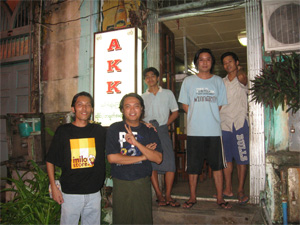Semester at
Sea Fall
2006 Voyage 
- Home Page
- My bio
- Transnational Ethnography: Issues of Vernacular Preservation: Migrants in Hong Kong and Spain
- Japan: Vernacular Atmosphere
- Hong Kong: A Family Abroad
- Vietnam:
The Numbing Effects of War Tourism
- Burma:Doctored
Perceptions of
Rangoon
- India: A Source of Contrasts
- Spain: Spain's Identity Crisis
- Open Letter
Doctored
Perceptions of
Jessica Von Wendel
A
global city
becomes global by catering to the desires of the global population. These cities cannot be completely inwardly
focused on the vernacular or else risk loosing the appeal that draws in
a
transnational flow. Currently,
As
I walk
down the streets of
It
is
primarily Indian men who sell ‘traditional’ Burmese handicrafts and
work as
money exchangers at the former British Scott Market that is now
predominantly designed
for tourists. In Donald M. Seekins’
article, “The State and the City: 1988 and the Transformation of
Rangoon”, he
describes these populations as “economically active populations of
immigrant
Indians and Chinese.” The economically
active description of these populations indicates that these migrants
are here
specifically to raise the status of the city.
 In
addition, the staged feeling of the city
is emphasized by spectacle buildings. The
construction of these facades attempts to deceive the foreign visitor. I walked into a little restaurant called AKK
near the Indian district of Rangoon. The
restaurant was pleasant, but when I used their restroom I peeked out
the back
door. I expected to see an alley, but
instead the area was completely closed off, like a courtyard, but with
mounds
of trash piled stories high. I asked if
it is ever collected. They just laughed
and said it has been piling up for years. No
one ever does anything about it.
In
addition, the staged feeling of the city
is emphasized by spectacle buildings. The
construction of these facades attempts to deceive the foreign visitor. I walked into a little restaurant called AKK
near the Indian district of Rangoon. The
restaurant was pleasant, but when I used their restroom I peeked out
the back
door. I expected to see an alley, but
instead the area was completely closed off, like a courtyard, but with
mounds
of trash piled stories high. I asked if
it is ever collected. They just laughed
and said it has been piling up for years. No
one ever does anything about it.
The
real situation of
course home page